Những vấn đề sinh viên chuyên ngữ Trường Đại học Duy Tân gặp phải trong việc dùng kết ngôn tiếng Anh trong cấu trúc “tôi + kết ngôn giữa động từ phi thực hữu và trạng từ nhận thức” trong giao tiếp
This study aims at examining the problems that English-Majored students at Duy Tan University in Da Nang, Viet Nam encounter in the use of the English pattern “I + Cognitive Non-factive Verb + Epistemic Adverb”. The pattern is herein referred to as “I + CNFV and EA” for short. The participants of the research were 162 English-majored students and 2 lecturers of English who specialize in English speaking skill teaching at Faculty of English, Duy Tan University. The students were asked to give answers to a questionnaire. The teachers were invited to participate in semi-structured interviews on their students’ knowledge of the “I + CNFV and EA” and on the problems that students are likely to encounter in using this pattern in communication. The findings showed that most of the students did not or rarely used this English pattern. They could not communicate successfully via this type of collocation since they were not fully aware of the usages and the effectiveness brought about by “I + CNFV and EA” for conveying such pragmatic features as decreasing complaining/admonishing, giving counselling, and reducing boasting. On account of this, it is hereby expected that the article will provide readers with some understanding of recognizable problems in using English collocations along with the possible tentative solutions that might be offered to the identified problems
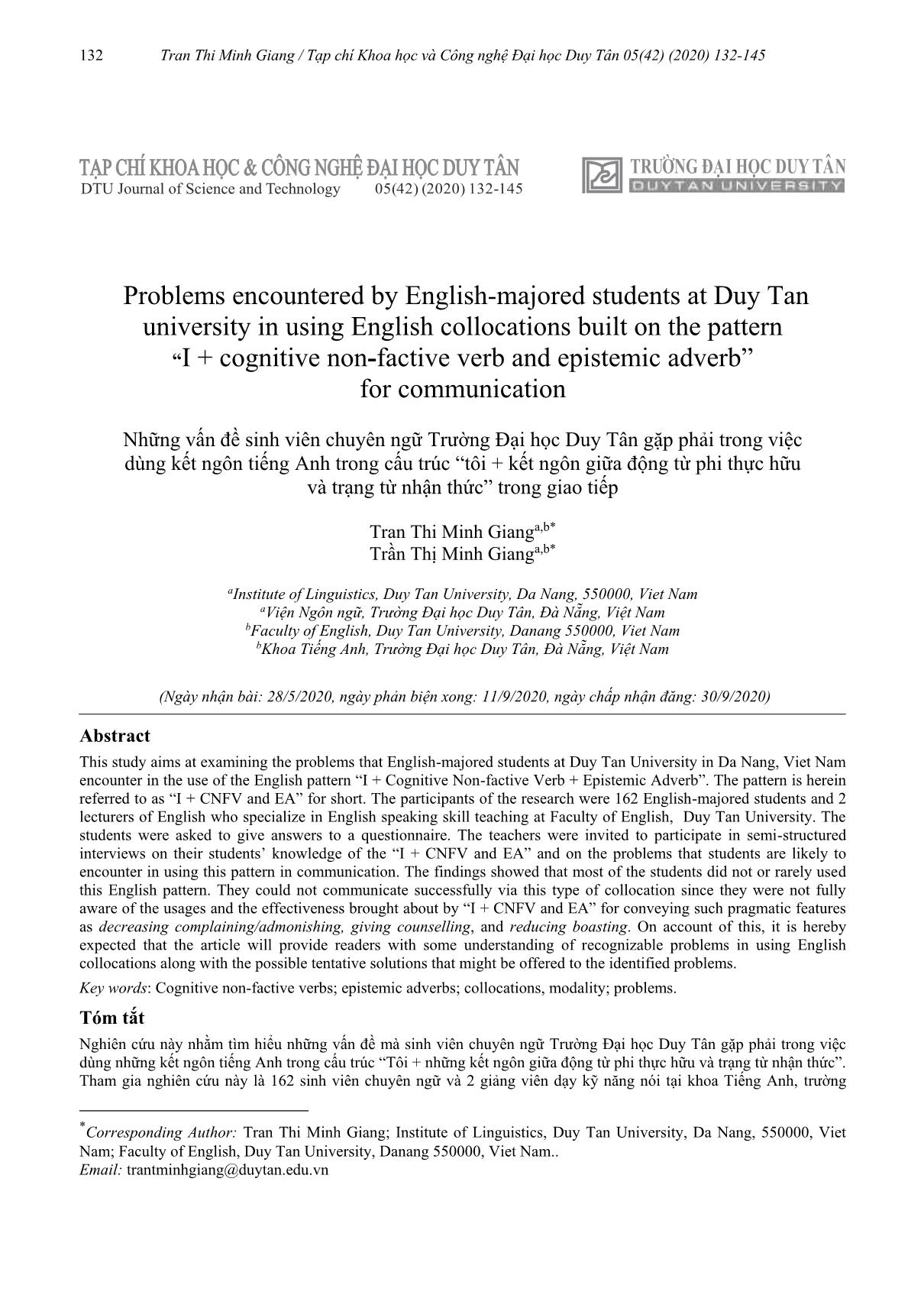
Trang 1
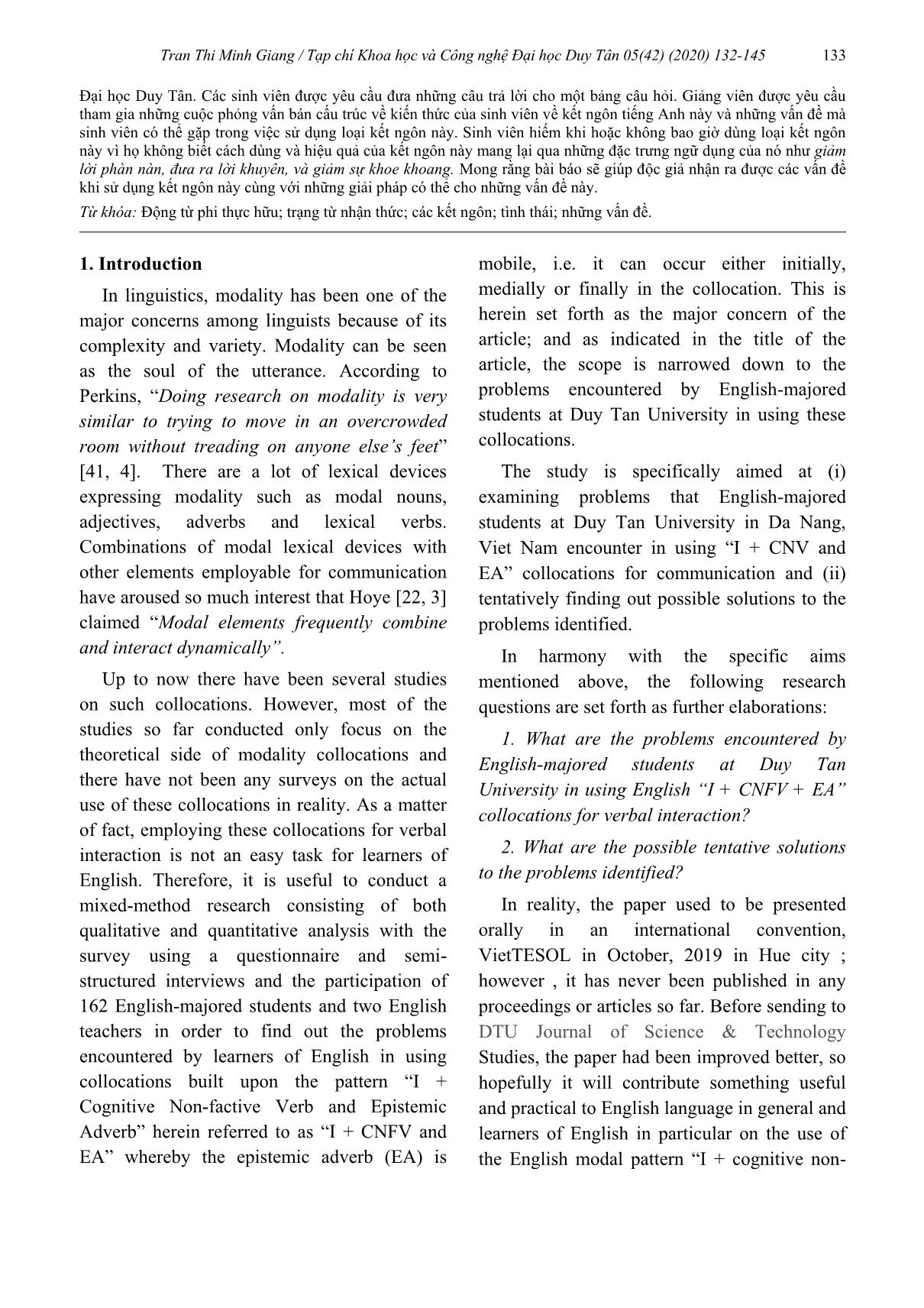
Trang 2
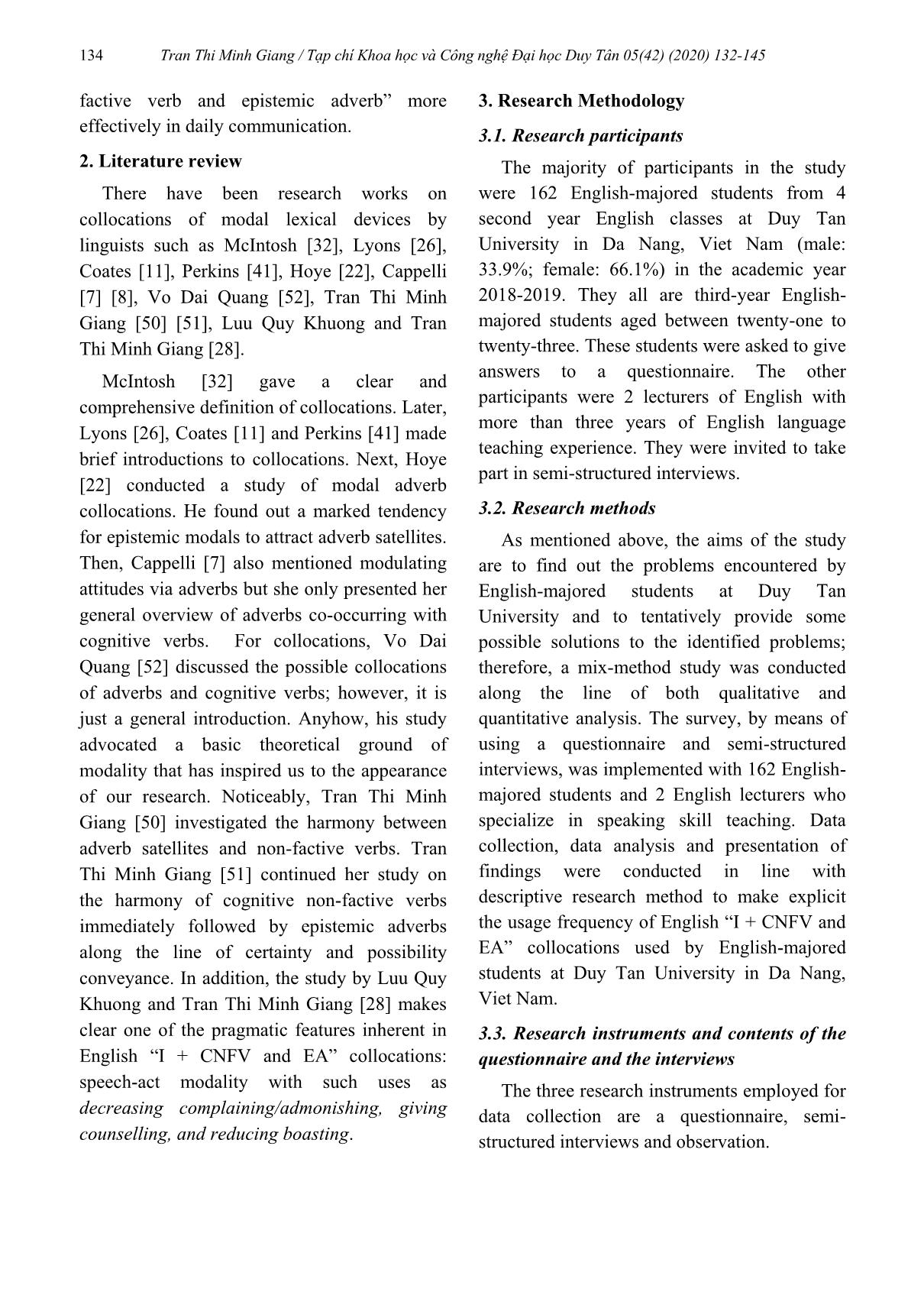
Trang 3
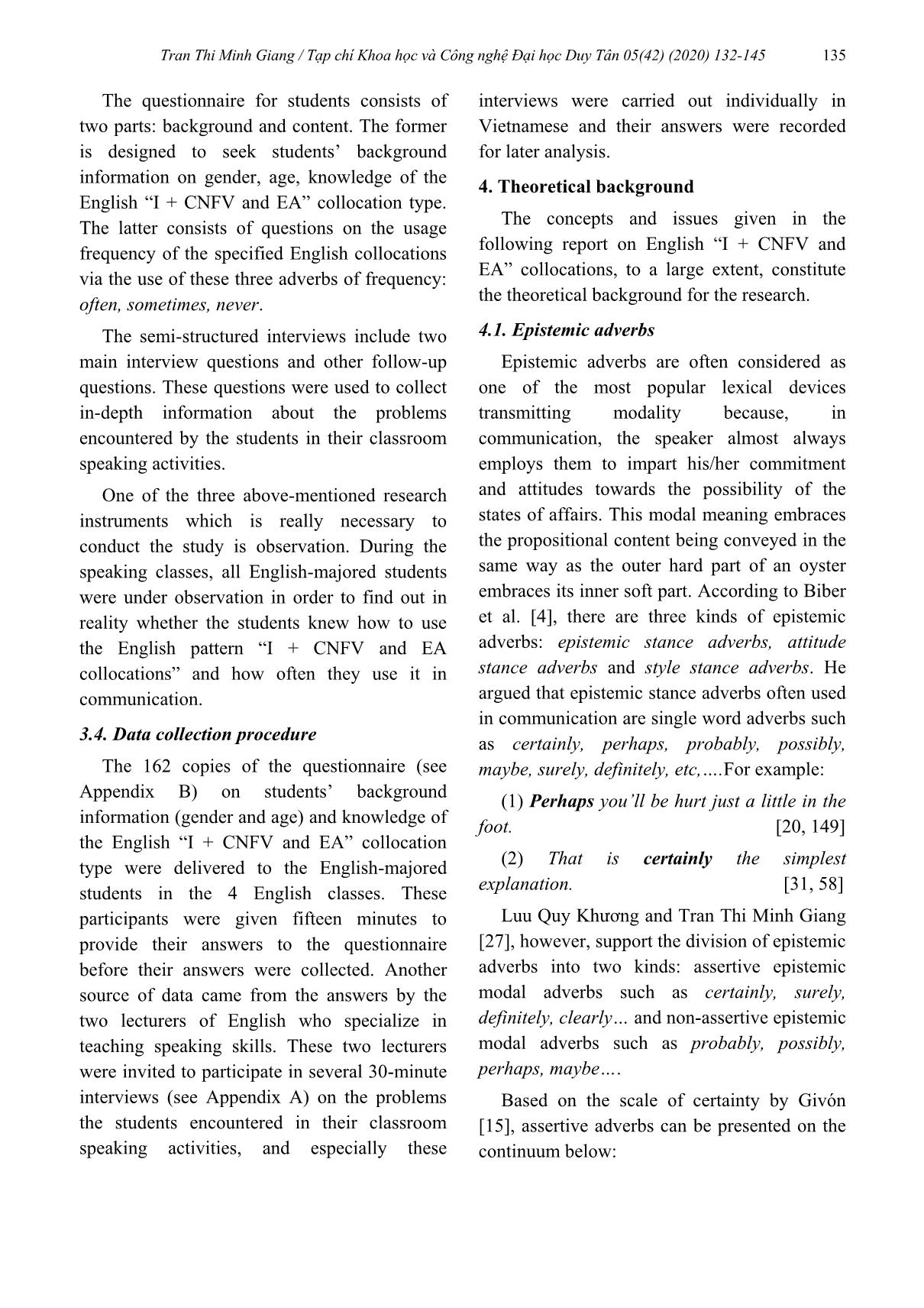
Trang 4
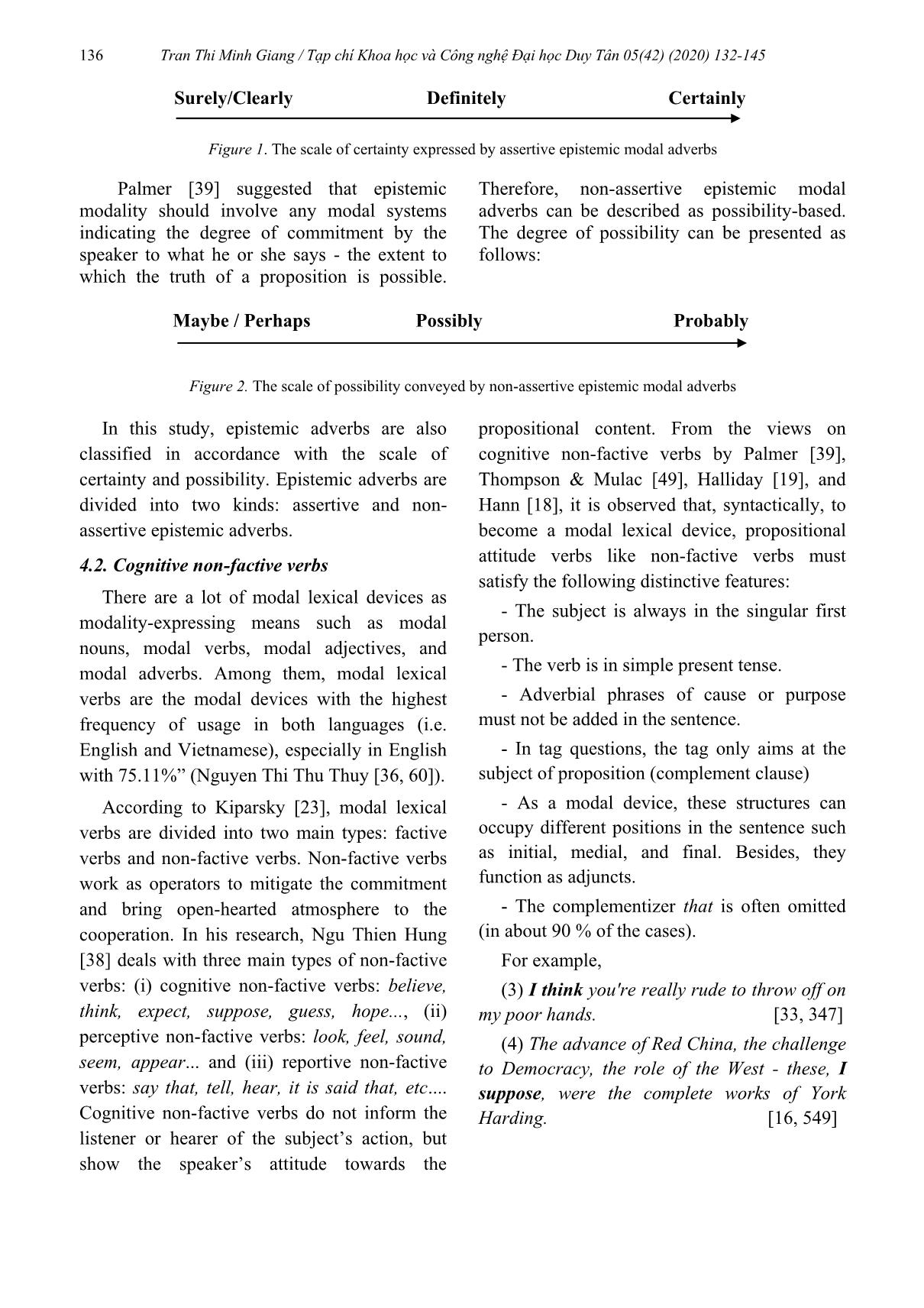
Trang 5

Trang 6
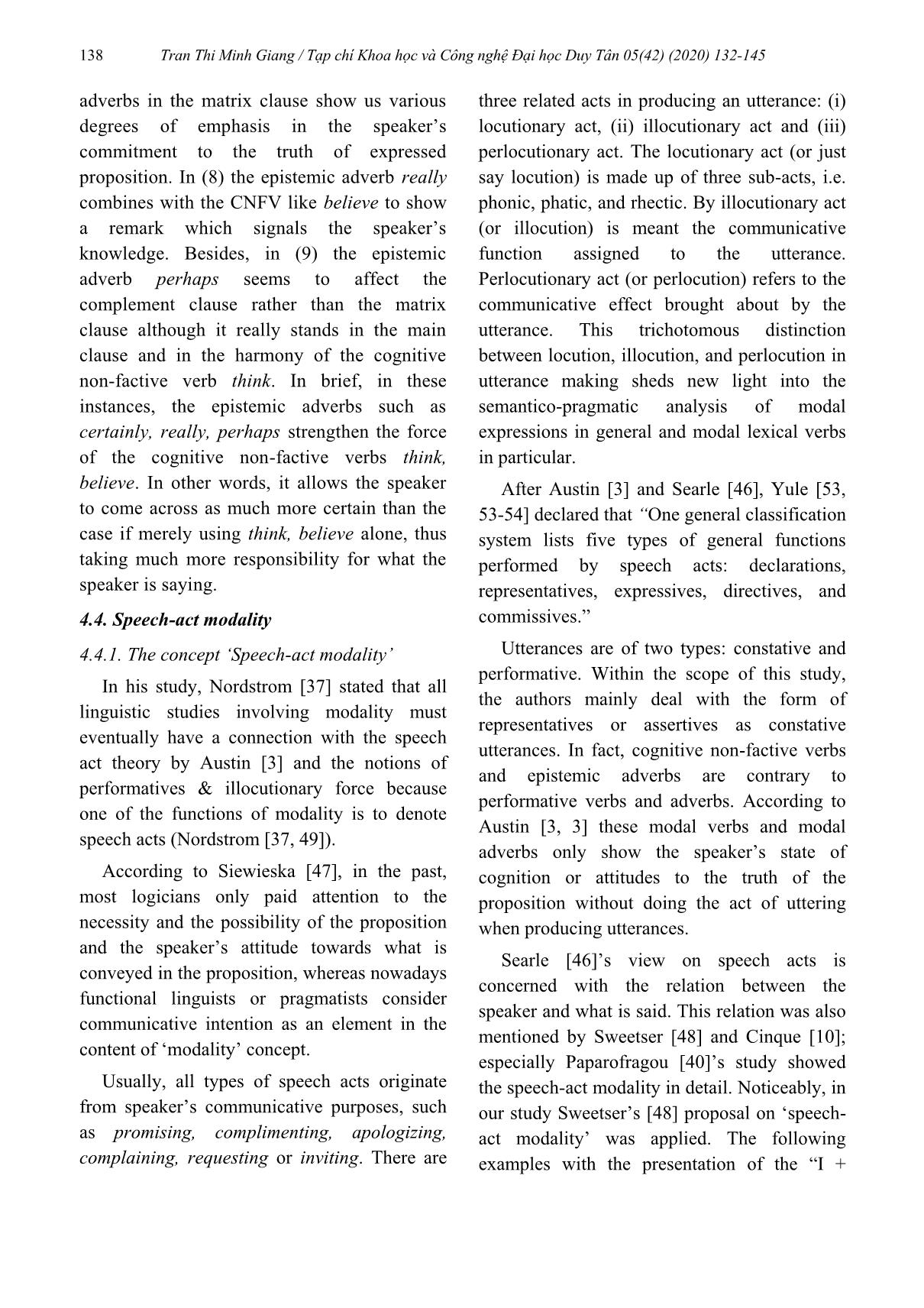
Trang 7
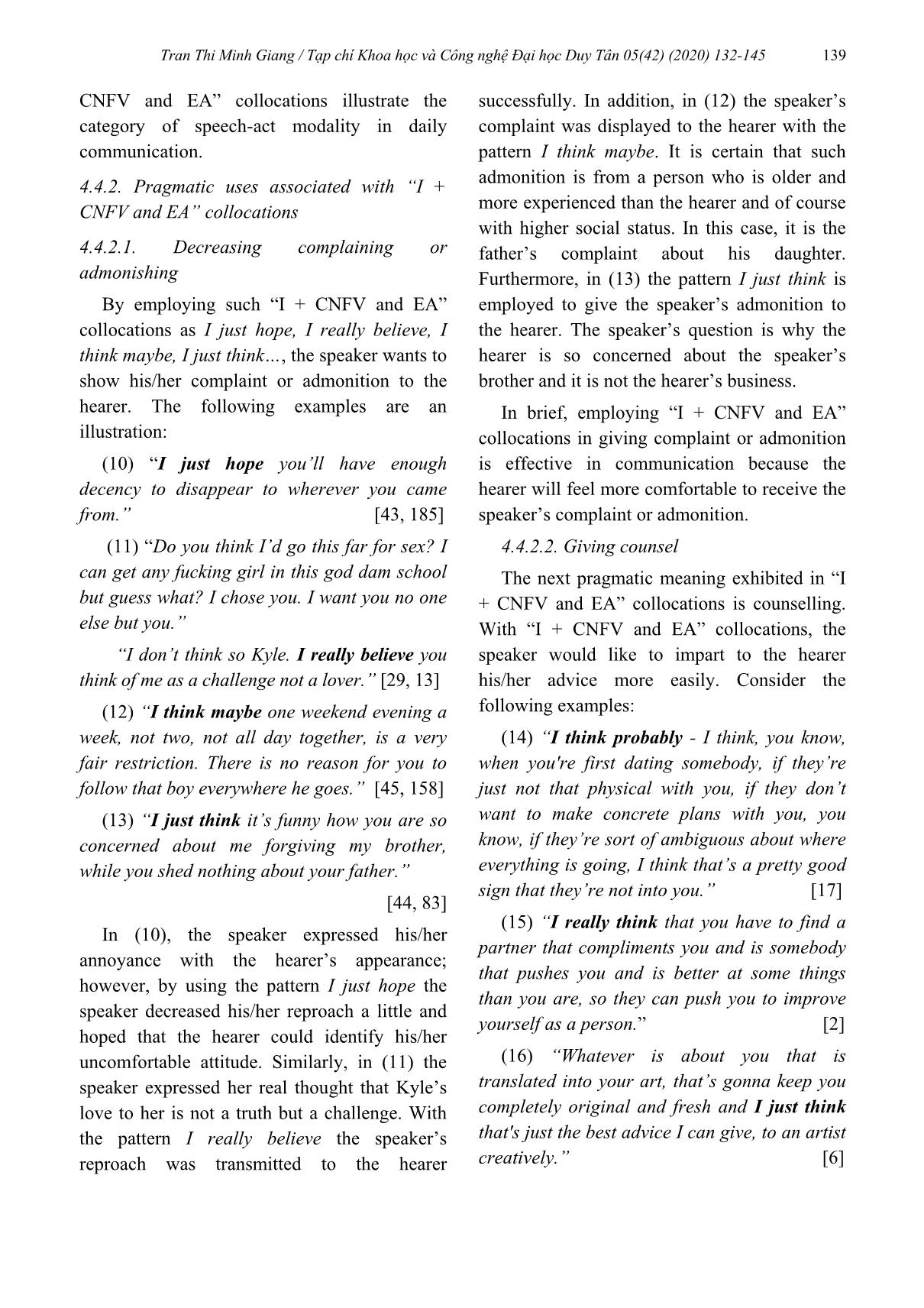
Trang 8
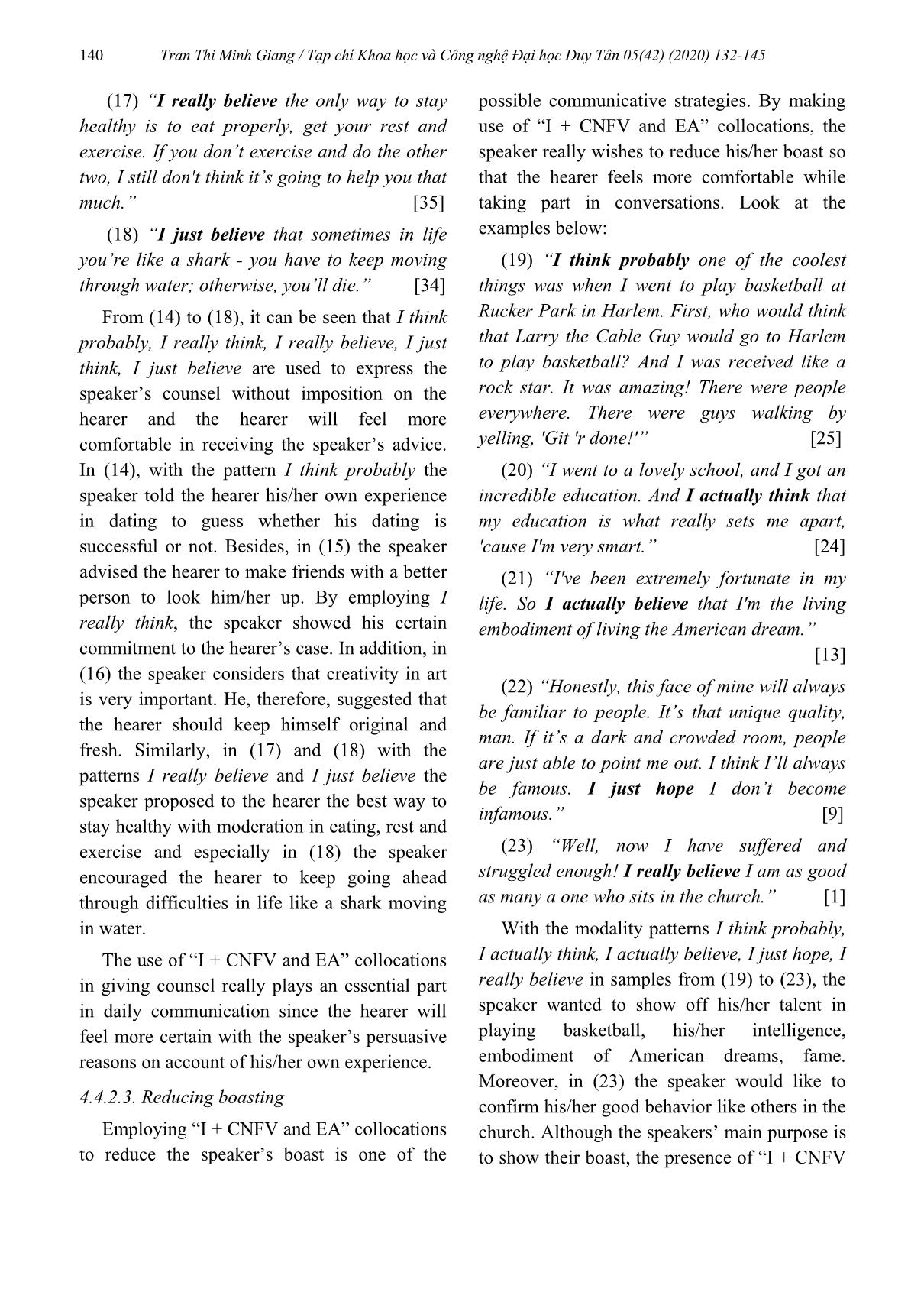
Trang 9
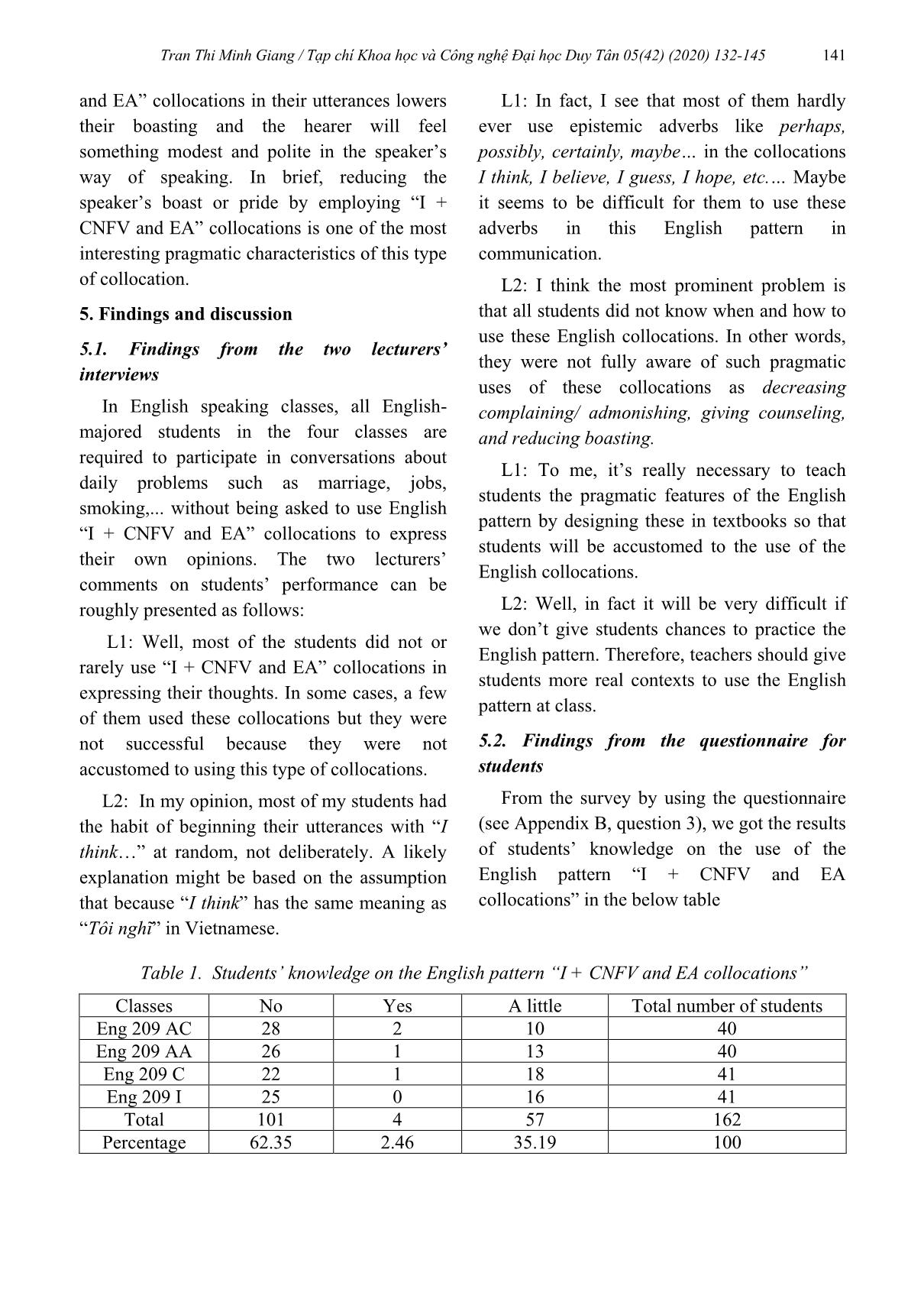
Trang 10
Tải về để xem bản đầy đủ
Tóm tắt nội dung tài liệu: Những vấn đề sinh viên chuyên ngữ Trường Đại học Duy Tân gặp phải trong việc dùng kết ngôn tiếng Anh trong cấu trúc “tôi + kết ngôn giữa động từ phi thực hữu và trạng từ nhận thức” trong giao tiếp
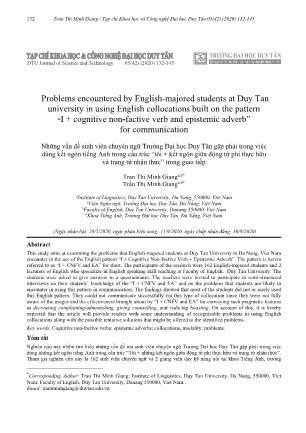
n. Therefore, teachers should give students more real contexts to use the English pattern at class. 5.2. Findings from the questionnaire for students From the survey by using the questionnaire (see Appendix B, question 3), we got the results of students’ knowledge on the use of the English pattern “I + CNFV and EA collocations” in the below table Table 1. Students’ knowledge on the English pattern “I + CNFV and EA collocations” Classes No Yes A little Total number of students Eng 209 AC 28 2 10 40 Eng 209 AA 26 1 13 40 Eng 209 C 22 1 18 41 Eng 209 I 25 0 16 41 Total 101 4 57 162 Percentage 62.35 2.46 35.19 100 Tran Thi Minh Giang / Tạp chí Khoa học và Công nghệ Đại học Duy Tân 05(42) (2020) 132-145 142 With the above results, the majority of students (62.35%) had no knowledge on the English pattern. Some of them (35.19%) had a little, and only few of them (2.46%) knew it. It is obvious that the English pattern is quite strange to most of them and of course all of them hardly ever knew pragmatic features of the English pattern. In addition, the findings on the usage frequency of “I + CNFV and EA” collocations are now provided in the following table: Table 2. Frequency of the use of the “I + CNFV + EA” collocations Frequency of the structure N0 % Never 143 88.27 Sometimes 19 11.73 Often 0 0 Total 162 100 The results from the survey questionnaire showed that most of the English-majored students (88.27%) never used “I+ CNFV and EA” collocations. Only a few of them (11.73 %) sometimes employed this type of collocation to express their own opinions. As a matter of fact, from the results of semi-structured interviews with the two lecturers and the survey by using the questionnaire, the question raised here is what are the problems that hinder students from using this type of collocation? These problems will be presented in the section that follows. 6. Conclusions Based on the findings mentioned above, the following concluding remarks on the specific aims of the study can be obtained: 6.1. Problems encountered by students at Duy Tan University in using English “I + CNFV and EA” collocations Some common problems that most Vietnamese students of English often meet when using English “I + CNFV and EA” collocations are as follows: The first observable problem is students’ lack of knowledge related to pragmatic features of English ‘I + CNFV and EA’ collocations. When giving their own opinions during the discussion, students rarely use “I + CNFV and EA” collocations as assertions for their strong claims. Most of them often present the descriptive information of the proposition with a highly strong force rather than give the hearer some open cooperation. In addition, the collocation “I think” is often used in the habit of beginning students’ utterances at random not on purpose because “I think” also has the same meaning as “Tôi nghĩ” in Vietnamese. Besides, they do not know they can use this collocation type for expressing such pragmatic meanings as decreasing complaining / admonishing, giving counseling, and reducing boasting. Another problem encountered by students is lack of real situations for students to practice using “I + CNFV and EA” collocations. In reality, mastering and using English “I + CNFV and EA” collocations in communication is not easy for the majority of learners of English as a foreign language because, generally, most English utterances used in classrooms are declarative, especially the purpose of sentences that students use in the classroom is to reply to teachers’ questions; therefore, they seldom express the speaker’s commitment to what is said and his/her attitude to the hearer. It means that learners of English do not have many real situations to use collocations of this type. One more problem encountered by students is the fact that due attention is not paid by Tran Thi Minh Giang / Tạp chí Khoa học và Công nghệ Đại học Duy Tân 05(42) (2020) 132-145 143 teachers to this type of collocation in the process of teaching. English “I + CNFV and EA” collocations are not properly evaluated by most Vietnamese teachers of English. Most of them only give their students Vietnamese translated versions or just explain grammatical properties of English “I + CNFV and EA” collocations. They pay little attention to the modal meanings inherent in these collocations, especially to the speaker’s attitude as an important component in the semantic structure of the utterance. Using English “I + CNFV and EA” collocations always requires the exact expression of speakers’ commitment to the truth of the proposition. However, textbooks never mention the use of English “I + CNFV and EA” collocations as a separate teaching/learning point and, as a result, students have difficulties in using this type of collocation in communication. It is hereby hoped that this study can provide an overview of linguistic features of “I + CNFV and EA” collocations to help teachers and learners of English gain an insightful look into the phenomenon under investigation. 6.2. Tentative solutions to the problems encountered by students at Duy Tan university in using “I + CNFV and EA” collocations In teaching the English “I + CNFV and EA” collocation by way of conversations, teachers need to analyze the speaker’s implication when using them; for example, the speaker can explain to students such pragmatic uses of “I + CNFV and EA” collocations in communication as decreasing complaining/ admonishing, giving counseling, and reducing boasting. Another solution to the problem is that teachers need to emphasize to students the fact that one aspect of “I + CNFV and EA” collocation is that commitment to degrees of certainty concerning the truth of what is said also affects the choice of cognitive non-factive verb (CNFV) and epistemic adverb (EA) that might appropriately be employed to express what needs to be conveyed in specific contexts. As mentioned above (item 6.1.), lack of real situations for students to practice using “I + CNFV and EA” collocations is one of the problems encountered by students. For the time being, as a tentative solution, teachers should give assignments in which students are encouraged to practice using this type of collocation, especially those that are designed to help students better comprehend the afore- mentioned pragmatic uses (as mentioned in item 4.4.2. above) of “I + CNFV and EA” collocations. As stated in 6.1., up till now, the use of “I + CNFV and EA” collocations has not been paid due attention to; so with a view to attracting teachers’ and students’ due attention to this collocation type, it is hereby proposed that “I + CNFV and EA” collocations should be designed as constituting a separate grammar teaching point in English textbooks. Besides, it is advisable that the English “I + CNFV and EA” collocation type ought to be taught at an early stage of learning. References [1] Andersen, H. C. (1992). Andersen’s fairy tales. Retrieved Monday, April 3rd, 2017 from ks/Andersens_Fairy_Tales_NT.pdf. [2] Ashton Kutcher quotes. Retrieved Wednesday, March 18, 2015 from n_kutcher.html [3] Austin, J. L. (1962). How to do things with words. Oxford: Oxford University Press. [4] Biber, D. et al (1999). Longman grammar of spoken and written English. London: Longman. [5] Birch Bayh quotes. Retrieved Thursday, March 19, 2015 from VTcCi72vaBqCRq.99 [6] Bubba Sparxxx quotes. Retrieved Wednesday, March 18, 2015 from Tran Thi Minh Giang / Tạp chí Khoa học và Công nghệ Đại học Duy Tân 05(42) (2020) 132-145 144 +I+just+think+that+....&pg=7 [7] Cappelli, G. (2005). Modulating attitude via adverbs: A cognitive – pragmatic approach to the lexicalisation of epistemological evaluation. In M. Bertuccell Papi (ed), Studies in the semantics of lexical combinatory patterns, Pisa: Plus Pisa University Press, pp. 213-278. [8] Cappelli, G. (2008). Antonymy and verbs of cognitive attitude: When know is the opposite of think and believe. Threads in the Complex Fabric Language, Linguistic and literary studies in honour of Lavinia Merlini, Pisa: Felici Editore, pp. 529-546. [9] CeeLo Green quotes. Retrieved Thursday, March 19, 2015 from +I+just+hope+that....&pg=6 [10] Cinque, G. (1999). Adverbs and functional heads. New York: Oxford University Press de Doktorwurde, Philosophische-Historrischen Fakutat de Universitat Bern. [11] Coates, J. (1983). The semantics of the modal auxilaries. Croom Helm. London. [12] Conan, D. (2014). The complete Sherlock Holmes. Retrieved Wednesday, September 20th, 2017 from https://www.bookrix.com/_ebook-anne- warner-a-woman-039-s-will-1/ [13] Dan Rosensweig quotes. Retrieved Thursday, September 15th, 2016 from actually+I+believe+that [14] Dickens, C. (1992). David Copperfield. Wordworth Classics. [15] Givón, T. (1982). Evidentiality and epistemic modality. Studies in Language, 6(1), 23-49. [16] Greene, G. (1980). The quiet American. Australia: Penguin Books. [17] Greg Behrendt quotes. Retrieved Wednesday, September 14th, 2016 from W7fIjsp0sx2LTWx.99 [18] Haan, F. de (1997). The interaction of modality and negation: A Typological Study. New York: Garland. [19] Halliday, M.A.K. (2004). An introduction to functional grammar. (3rd ed.) London: Arnold. [20] Hemingway, E. (1993). A farewell to arms. New York: Everyman’s library. [21] Hemingway, E. (1954). The sun also rises. New York: The Viking Press. [22] Hoye, L. (1997). Adverbs and modality in English. London: Longman. [23] Kiparsky, P. (1968). Linguistic universals and linguistic change. In E.Bach and R. Harms (eds.), Universals in Linguistic Theory (pp. 171- 210). New York: Holt, Rinehart and Winston. [24] Lady Gaga quotes. Retrieved Monday, September 19th, 2016 from I+actually+think+that+....&pg=10. [25] Larry the Cable Guy quotes. Retrieved Monday, September 19th, 2016 from UlKLmU7OyS4Sww.99 [26] Lyons, J. (1977). Semantics, Two volumes. Cambridge: Cambridge University Press. [27] Lưu Quý Khương & Trần Thị Minh Giang (2012). Nghiên cứu một số đặc trưng ngữ dụng của trạng từ tình thái nhận thức khẳng định và không khẳng định trong tiếng Anh. Ngôn ngữ, 5(276), 50-56. [28] Lưu Quý Khương,&Trần Thị Minh Giang (2018). “Pragmatic features of the structure I + cognitive non-factive verb and epistemic adverb collocations’”, University of Languages and International Studies – VNU, 4(34), pp. 59-70. [29] Madeline P. (2012). To love a player. Retrieved Monday, September 6th, 2017 from https://www.bookrix.com/_ebook-madeline-piper- to-love-a-player/ [30] Maugham, S. (2013). Of human bondage. Retrieved Friday, April 14 th, 2017 from ks/Of_Human_Bondage_NT.pdf [31] Maugham, W. S. (1996). The moon and six pence. New york: Mandarin. [32] McIntosh, A. (1961). Patterns and ranges. Language, 37(3), 325-337. [33] Mitchell, M. (1947). Gone with the wind. London: The Macmillan Company. [34] Michelle Ryan quotes. Retrieved Monday, September 19th, 2016 from +I+just+believe+that...&pg=5. [35] Mike Ditka quotes. Retrieved Monday, September 19th, 2016 from +I+only+believe+that...&pg=6 [36] Nguyễn Thị Thu Thủy (2012). Tính tình thái chủ quan và tình thái khách quan trong các văn bản khoa học tiếng Anh và tiếng Việt. Ngôn ngữ, 6, 52-68. [37] Nordstrom, J. (2010). Modality and subordinators. Amsterdam/ Philadelphia: John Benjamins Publishing company. [38] Ngũ Thiện Hùng (2004). Khảo sát các phương tiện từ vựng ngữ pháp biểu đạt tính tình thái nhận thức trong tiếng Anh-Việt. Hà Nội: Luận án tiến sĩ. Tran Thi Minh Giang / Tạp chí Khoa học và Công nghệ Đại học Duy Tân 05(42) (2020) 132-145 145 [39] Palmer, F. R. (1986). Mood and modality. Cambridge: Cambridge University Press. [40] Papafragou, A. (2000). On Speech-Act modality. Journal of Pragmatics, 32, 519-538. [41] Perkins, M. R. (1983). Modal expressions in English. London: Longmans Press. [42] Quirk, R., Greenbaum, S., Leech G., Svartvik, J. (1985). A comprehensive grammar of the English language. London: Longman. [43] Rahela F. (2012). The storm child. Retrieved Monday, September 6th, 2017 from https://www.bookrix.com/_ebook-rahela-ferrari-the- stormchild-completed/ [44] Raven H. (2009). Bedful of moonlight. Retrieved Monday, September 6th, 2017 from https://www.bookrix.com/_ebook-raven-held- bedful-of-moonlight/ [45] Sara, E. R. (2013). On Emma’s bluff. Retrieved Wednesday, August 23rd, 2017 from https://www.bookrix.com/_ebook-sara-e-rice-on- emma-039-s-bluff/ [46] Searle, J. R. (1969). Speech Acts: An Essay in the Philosophy of Language. Cambridge: Cambridge University Press. [47] Siewierska, A. (1991). Functional grammar. London: Routledge. [48] Sweetser, E. (1990). From etymology to pragmatics. Cambridge: Cambridge University Press. [49] Thompson, S. A. & Mulac, A. (1991). A quantitative perspective on the grammaticization of epistemic parentheticals in English. In Traugott and Heine (eds), Approaches to Grammaticalization, 2, 313-329. [50] Trần Thị Minh Giang (2011). A study of linguistic features of non-factive verbs in English versus Vietnamese. Master Thesis in English Language, The University of Danang. [51] Trần Thị Minh Giang (2015). A study of the pragmatic dimension of epistemic adverbs on cognitive non-factive verbs in English. The University of Danang- Journal of Science and Technology, 6(91), 140-142. [52] Võ Đại Quang (2009). Một số phương tiện biểu đạt nghĩa tình thái trong tiếng Anh và tiếng Việt (sách chuyên khảo phục vụ đào tạo đại học và sau đại học). Hà Nội: NXB Đại học Quốc gia Hà Nội. [53] Yule, G. (1996). Pragmatics. Oxford: Oxford University Press. Appendices Appendix A Main questions used in the semi-structured interview for two lecturers 1. What do you think about English-majored students’ knowledge on the English pattern “I+ CNFV and EA collocations”? 2. What problems do students often encounter when using the English pattern “I + CNFV and EA collocations”? 3. What suggestions should you give to improve the problems? Appendix B Questions for students’ survey questionnaire 1. What is your age? - 21 - 22 - 23 - over 23 2. What is your sex? - Male - Female 3. Do you know how to use the English pattern “I + CNFV and EA collocations” in communication? - No - A little - Yes 4. How often do you use the English pattern “I + CNFV and EA collocations” in communication? - Never - Sometimes - Often
File đính kèm:
 nhung_van_de_sinh_vien_chuyen_ngu_truong_dai_hoc_duy_tan_gap.pdf
nhung_van_de_sinh_vien_chuyen_ngu_truong_dai_hoc_duy_tan_gap.pdf

